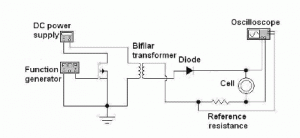Separation between charging and charge transition currents with inductive voltage pulses
 Separation between charging and charge transition currents with inductive voltage pulses
Separation between charging and charge transition currents with inductive voltage pulses
Authors:Â Martins Vanags, Janis Kleperis, Gunars Bajars
Abstract
Inductive voltage pulses are generated in electric circuit consisting from DC power source, pulse generator, field transistor BUZ350, blocking diode and transformer wound as bifilar. Very short inductive voltage pulses arising from current disruption in primary circuit (>1 μs) are applied to water electrolysis cell. Quick cell charging is observed, which transforms in a relatively slower discharge tail. The oscilloscope is used to take voltage and current pulses from the cell consisting from steel electrodes and water-KOH solution. By changing the concentration of electrolyte and distance between electrodes, it is proved that using inductive voltage pulses to power electrolysis cell, it is possible to separate both the double layer charging current from the charge transition (Faradic) current.